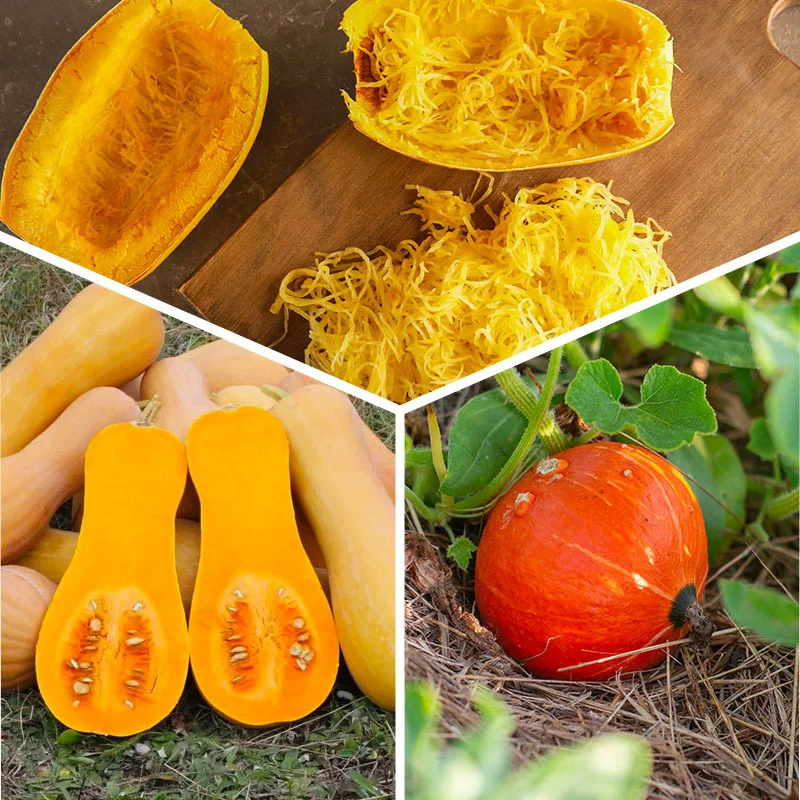3 plants Assorted squash AB
Explore part of the vast squash universe with this trio of must-have varieties belonging to different botanical species: Red Kuri (Cucurbita maxima), Spaghetti Végétal (Cucurbita pepo) and Butternut Nutterbutter (Cucurbita moschata). Find out when and how to plant these squashes in the vegetable garden, and transform your space into a festival of delicious autumn vegetables to be enjoyed straight from the harvest, or stored all winter long.
- Red Kuri squash
The Red Kuri pumpkin produces small, brick-red, top-shaped fruits weighing 1.5 to 2 kg, with succulent, sweet orange flesh and the chestnut flavor characteristic of pumpkins. They keep for 4 to 8 months, depending on storage conditions.
- Vegetable Spaghetti Squash
Spaghetti Végétal, an ancient variety from China with vigorous growth, offers 2 to 5 elongated fruits, white before turning amber-orange at maturity, weighing 1 to 3 kg. Their low-calorie, orange-yellow flesh breaks down into spaghetti-like strands when cooked. These squashes keep for 6 to 12 months.
- Butternut Nutterbutter squash
Nutterbutter is a butternut variety selected for its earliness and resistance to mildew. It produces small fruits, around 17 cm long and weighing 1 to 1.8 kg, with a delicious nutty flavor.
When to plant squash?
As soon as frosts are no longer a concern and the soil has warmed up sufficiently, generally from April to June depending on the region, plant squash plants in the vegetable garden at least 1 m apart in all directions.
However, squash root systems develop very quickly, and plants can quickly become cramped in their pots. If the cooler weather doesn't allow you to plant them in the ground, transplant the plants into a bucket or a larger pot:
- Place a mixture of universal potting soil and garden soil in a larger pot, a third of the way up;
- remove the seedlings from the pot;
- place them at the bottom of the pot;
- fill to within 1 cm of the pot's rim with the potting mix;
- pack lightly;
- water.
How to plant squash
For a good squash planting in the vegetable garden:
- dig holes about 20 cm wide and deep, at least 1.5 m apart in all directions;
- place a good handful of well-decomposed compost at the bottom;
- unstack the plants;
- place them upright in each hole;
- close up and pack lightly around the plants;
- water generously;
- mulch.
When to harvest squash
Squash are generally harvested from July to November, when the skin becomes thick and ripe, and the stalk begins to dry out.
Squash for winter storage can be picked as late as possible, but before the first frost.
What to plant next to squash?
Although combining crops in the vegetable garden can improve yields, repel certain pests and diseases, or optimize available space, it should not become a constraint or an obstacle, and should be thought through before planting, according to your expected objectives.
A squash plant can run for several meters, so it quickly takes up space. To optimize this space, plant fast-cycling varieties at the foot of the squash:
- lettuce ;
- rocket ;
- watercress
- radish ;
- etc.
All aromatic plants such as basil, chives, wormwood, etc. repel certain insect pests thanks to their powerful fragrance. Nasturtiums also tend to attract aphids and bugs. Installed near squash plants, it prevents them from attacking the food crops.
All melliferous plants such as borage, phacelia, marigold, sunflower, etc. are also good companions for squash. They attract a host of pollinating insects essential for good pollination of the flowers and preventing the developing fruit from turning brown and aborting.
Shipping and delivery of squash assortment
- Orders are dispatched Monday to Thursday.
- Shipment to mainland France only.
- Shipping cartons designed for optimal plant protection.
- Free shipping does not apply to seedlings.










